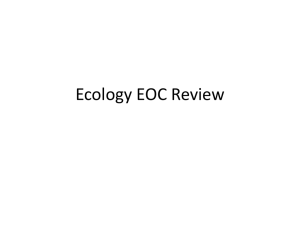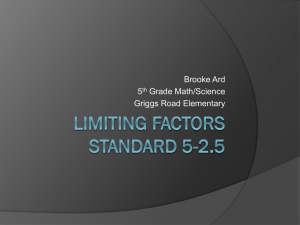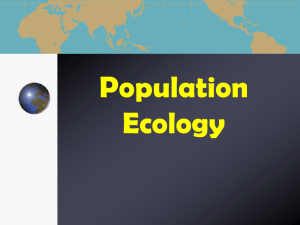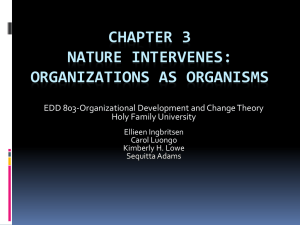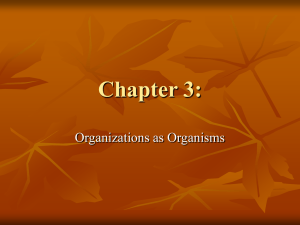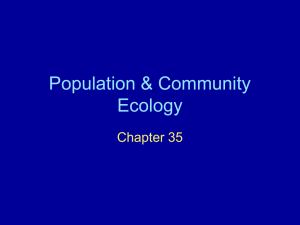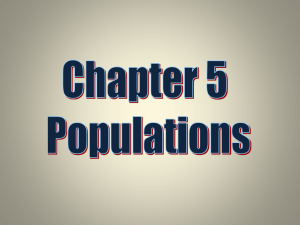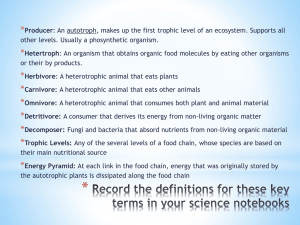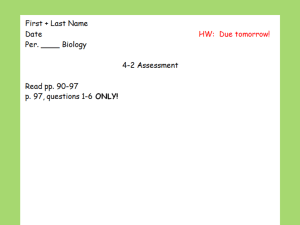Ecology
advertisement
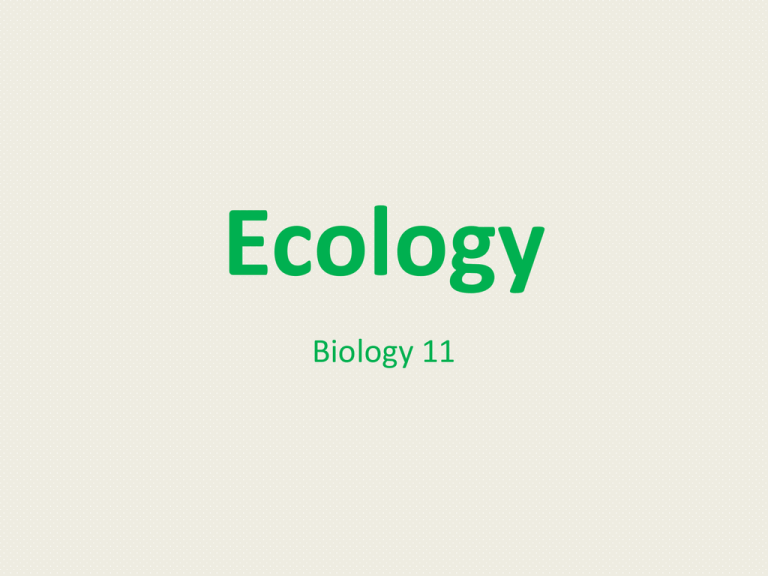
Ecology Biology 11 What is Ecology? • the study of the interactions that take place between organisms and their environments The Biosphere • The part of the Earth that supports living things Non-Living Environment • Abiotic factors are non living parts of an environment • Often determine which species survive in a certain environment • Include air currents, temperature, moisture, light, and soil Analyzing Graphs • Question: How does an abiotic factor affect food production? • Green plants carry out the process of photosynthesis. Glucose, a sugar, is the food product made during this process. Glucose production can be used as a means for measuring the rates at which the process of photosynthesis is occurring. • Examine the following graph of a plant called saltbush. 1. What is the abiotic factor influencing photosynthesis? How does this factor affect photosynthesis? 2. How much glucose is being produced at 20 degrees? 3. Based on the graph, at which temperature is glucose production greatest? 4. Does the graph tell you how the rate of photosynthesis might vary for plants other than saltbrush? Explain your answer. What happens to the formation of glucose after the temperature reaches 30 degrees? • A complete study of an organism includes examination of the abiotic factors influencing the organism Ex. Study of salmon life cycle would include whether needed to lay eggs on rocky or sandy stream bottoms Living Environment: Biotic Factors • All living organisms that inhabit the environment are called biotic factors • All organisms depend on others either directly or indirectly – Food, shelter, reproduction, protection… Levels of Organisation • Population – A group of organisms of the same species that interbreed and live in the same area at the same time – Members of a population may compete for resources (food, water, mates, habitat…) • Communities – Made up of interacting populations in a certain area at a certain time • Ex. Birds eating insects, mushrooms growing on decaying leaves – A change in one population within a community may cause changes in other populations • Ecosystem – Made up of interacting populations in a biological community and the community’s abiotic factors • 2 major kinds of ecosystems: –Aquatic –Terrestrial Terrestrial Ecosystems Forest Meadow Rotting log Aquatic (Freshwater) Ecosystems Pond Lake Stream Aquatic (Salt water) Ecosystems Ocean Estuary Intertidal Zone Symbiosis • Means living together • Is the relationship in which there is a close and permanent association between organisms of different species • Includes mutualism, commensalism, parasitism Mutualism (+/+) • Both species benefit from association • Example: Ants and Acacia trees Commensalism (+/0) • One species benefits, the other species is neither harmed nor benefitted • Example: Remora fish Parasitism (+/-) • Harmful to one species but beneficial to the other • Evolved relationship where parasite harms, but does not usually kill host • Example: Tick Brood Parasitism • Ex. Brown-headed cowbird – Lay eggs in nests of song birds Other interactions… • Competition – Between individuals of the same species or between different species – For resources such as food, water, sunlight, space • Predation – One individual eats all (or part) of another organism Altruism • A behaviour that may be a disadvantage to the individual, but benefits other • Or… a behavioural that is detrimental to the individual but favours the survival of that individuals genes through relatives Ecosystems Change over Time • Succession: orderly, natural changes and species replacement that take place in the communities of an ecosystem • Takes place in stages • Different species of plants and animals may be present at each stage (different conditions) • Takes place over decades or centuries • 2 types of succession 1) Primary Succession • Colonization of barren land (no living organisms) • Examples: Following volcanic eruption or retreat of glacier • First species to take hold are pioneer species (ex. Lichens) • Pioneer species eventually die, decay, and change the landscape for the next stages • Over time a climax community matures • This community is stable and undergoes little or no change • Could last hundreds of years 2) Secondary Succession • Sequence of changes that takes place after an existing community is severely disrupted (ex. Forest Fire) • During succession the community of organisms inhabiting an area gradually changes • Secondary succession takes place in a region that previously contained life, and still contains soil. • Involves different pioneer species and takes less time to reach climax community than primary succession Interpreting Scientific Illustrations • Succession is the series of gradual changes that occur in an ecosystem. Ecologists recognize two type of succession- primary and secondary. • Examine the graph. The lines marked 1 and 2 represent primary and secondary succession (but neither is defined for you) 1) Which line, 1 or 2, represents primary succession? Secondary succession? Explain. 2) Which label, C or D, might best represent a climax community? Pioneer organisms? Explain. 3) What does the sudden drop at point C represent? What happens between D and E? • Begin Ecology Questions • Work on Vocab (due Friday) Nutrient and Energy Flow Biology 11 The Producers • Autotroph- uses light energy or energy stored in chemical compounds to make energy rich compounds • Ex. Grass and trees Photosynthesis • Process in chlorophyll that takes water, light, and CO2 and produces sugar • H2O + CO2 + light ---> C6H12O6 or glucose • The sugar is then used as a building block for amino acids, cellulose, or starch (for the plant to use later) Cellular Respiration • C6H12O6 + O2 → CO2 + H2O + Energy Plants: • H2O + CO2 + light ---> C6H12O6 or glucose Us: • C6H12O6 + O2 → CO2 + H2O + Energy They keep making it, we keep breaking it down (they break it down too) The Consumers • Organisms that get their energy from producers • Primary consumers: Obtain energy by directly consuming producer (herbivores) • Secondary consumers: Obtain energy by eating primary consumers (carnivores) • Energy flow: Producer Primary Consumer Secondary Consumer Tertiary/Quaternary Consumer Decomposers- organisms that obtain energy through the break down of non-living organic materials (dead organisms) – Include bacteria and fungi. • Food Chain: simple model shows how matter moves through an ecosystem • Each organism in a food chain represents a trophic level • Food Web: show all possible feeding relationships at each trophic level within a community Ecological Pyramids • Shows how energy moves through an ecosystem • Base of pyramid represents autotrophs (1st trophic level) • Some of the energy transferred at each trophic level enters the environment as heat (less available at each higher level) • ~10% of total energy is transferred from one trophic level to the next Pyramid of Numbers Pyramid of Biomass Pyramid of Energy • Where would you expect the largest biomass? • What do you think the world’s largest organisms eat? Why? https://what-if.xkcd.com/78/ Biogeochemical Cycles • Organisms not only need energy for survival, but also nutrients • Water, Phosphorous, Nitrogen, Carbon Dioxide, and Oxygen are all cycles in the environment • These nutrients move through the biosphere differently than energy Limiting Factors • Are factors that affect an organism’s ability to survive in its environment • Include water, food, predators, temperature • Limiting factor: any biotic or abiotic that restricts existence numbers, reproduction, or distribution of organisms Common Limiting Factors • • • • • • • • • Sunlight Climate Temperature Water Nutrients/Food Fire Soil Chemistry Space Other Organisms • Do questions page 1027 #1, 2, 4, 5 and page 1030 #1-8, TF 1-8, CM # 1, 2, 4, 7, 8 Tomorrow: • Activity: Birds, Bugs, or Beans • Human Population Growth Population Growth How many people can the Earth hold? Biology 11 Principles of Population Growth • Population: a group of organisms of the same species that live in a specific area • Healthy populations will grown and die at a steady rate (unless it runs out of resources, is attacked by predators or disease) • What would you expect population growth to look like if resources were abundant? Graph it. Exponential Growth • The growth of a population starts slowly, then begins to look like a J-shaped curve • Initial growth is slow because the number of reproducing individuals is small • Rate of population growth increases because the total number of individuals able to reproduce has increased • This is exponential growth • Is growth unlimited? • No: different limiting factors (resources, predators, disease…) • Under these pressures, populations may stabilize into an S-shaped growth curve Carrying Capacity • The number of organisms of one species than an environment can support indefinitely • If a population is in an environment with resources, there are more births than deaths and population will increase until carrying capacity is reached/passed • When population overshoots the carrying capacity, limiting factors have effect • Deaths exceed births and lower population below carrying capacity What might be some limiting factors? Factors Affecting Population Growth • Limiting factors: biotic or abiotic factors that determine whether an organism can live in a particular environment • There are two kinds of limiting factors that are related to dispersal – Density-dependent factors – Density-independent factors • Population Density: number of individuals in a given area Density Dependent • Have increasing affect as population density increases • Includes disease, competition, predators, parasites, food, crowding Competition • When populations become crowded, organisms compete for food, water space, sunlight and other essentials. • Competition among members of the same species is a density-dependent limiting factor. Predation • Populations in nature are often controlled by predation. • The regulation of a population by predation takes place within a predator-prey relationship, one of the best-known mechanisms of population control. Parasitism and Disease • Parasites can limit the growth of a population. • A parasite lives in or on another organism (the host) and consequently harms it. Density Independent • Can affect populations regardless of density • Most are abiotic factors – Volcanic eruptions, temperature, storms, floods, drought, chemical pesticides, and major habitat disruption • Human Population Clock Crops are on the rise, and we use them poorly… • The combination of growing corn, beans, and squash, produces a average total of 2.7 million calories per acre or enough with all arable land in production to feed 2.5 times the population in 2050. • The USDA accepted 3.9 million new acres into the Conservation Reserve Program, or CRP, in the latest sign-up period and turned away 600,000 acres
